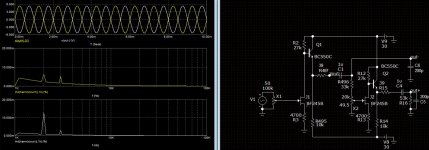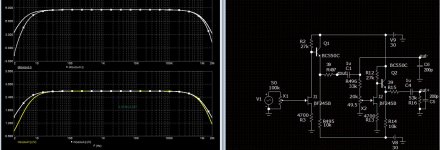Simple. Once upon a time, before they invented the feedback loop, to lower the second harmonic distortion, two identical inverting circuits were placed in cascade.Secret of japanese audiophiles is to put two preamps one after another.
I have already asked that question, what are the pros and cons, and noone replied.
Anyway, i am here to learn, and put some more shades on mona lisa, like bimo and tillerson.
Things are definitely not that simple. Two preamps one after another, each has its own negative feedback loop.
Two identical preamps in series do not reduce 2nd harmonic. Inverting or not.
Not sure what you mean by cascade.
Two identical preamps in series do not reduce 2nd harmonic. Inverting or not.
Not sure what you mean by cascade.
You said that already. No need to repeat yourself. And i said i do not believe you. You need to provide proof of such claim.
Two inverting stages were placed in series in the past in order to achieve high gain and noninverting nature. Nothing to do with reducing 2nd harmonic.
Well known stage reducing second harmonic is push-pull stage. Not two preamps in series.
Two inverting stages were placed in series in the past in order to achieve high gain and noninverting nature. Nothing to do with reducing 2nd harmonic.
Well known stage reducing second harmonic is push-pull stage. Not two preamps in series.
Two identical inverting stages in series does reduce even harmonics, this is a mathematical fact, the even harmonics tend to cancel, odd harmonics can only add.
Splitting a high gain stage into two steps does indeed help when each stage uses feedback (higher bandwidth and lower distortion due to much more effective feedback in each stage), if not using feedback its not clear cut.
Splitting a high gain stage into two steps does indeed help when each stage uses feedback (higher bandwidth and lower distortion due to much more effective feedback in each stage), if not using feedback its not clear cut.
Literature? Data, proof?Two identical inverting stages in series does reduce even harmonics, this is a mathematical fact, the even harmonics tend to cancel, odd harmonics can only add.
There is no negative global feedback in hamtone circuit.Splitting a high gain stage into two steps does indeed help when each stage uses feedback (higher bandwidth and lower distortion due to much more effective feedback in each stage), if not using feedback its not clear cut.
If very high gain was required in the past, using poor opamps, it was beneficial to split into two stages with each lower gain, because one stage with high gain led to poor high frequencies with distortion.
This has nothing to do with two inverting preamps being discussed.
Btw, gentlemen, i do not care about seeing sine wave with little 2nd harmonic going up in first pre, and going down in second pre. Or matematical model.
I do not listen to sine wave, hopefully you do not either. I listen to music.
Apply very complex signal (music) to first preamp, see distortion and noise going up.
Apply this even more complex signal to second pre. See noise and distortion going even higher.
Please provide proof 2nd harmonics was lowered.
I do not listen to sine wave, hopefully you do not either. I listen to music.
Apply very complex signal (music) to first preamp, see distortion and noise going up.
Apply this even more complex signal to second pre. See noise and distortion going even higher.
Please provide proof 2nd harmonics was lowered.
Well its sort of obvious from the symmetry of odd and even functions, but if you can't see that, here's the equationsLiterature? Data, proof?
f(x) = -(x + a*x^2), basic 2nd order distortion in inverting gain of 1, 0 < a << 1
g(x) = f(f(x)) apply twice
therefore g(x) = -(-(x + a*x^2)) - a*(x + a*x^2)^2 = x + a*x^2 - a*x^2 - 2*a^2*x^3 - a^3*a^4
If a = 0.01, thats: x - 0.0002 x^3 - 0.000001 x^4, the 2nd order term has cancelled, leaving much less 2nd-order distortion (the higher order terms will introduce some, but at a lower level).
The multiple angle formulae convert these powers to spectra,
This all requires a to be small to start with, but we hope that's the case!!
Do not want to be smart ***, but hamptone was primarily designed to be solid state pre emulating tubes, with tons of 2nd harmonic distortion. My data show anywhere to 0.6% pure second harmonic. Why would you configure pre to generate 2nd harmonic at first place, only to try to remove it?
The volume pot adds noise, so placing it first in the chain means that the pre-amp amplifies that noise and results in the lowest SNR option. On the other hand, you are only asking the amplification stage to produce the exact output you want, so is best from a dynamic range perspective.Because, everyone of you noticed, Hamptone, just like some other pre has two stages with volume pot in the middle. Why?
The highest SNR solution would be to have the volume pot after all of the amplification in the preamp, but this can have a couple of issues: a) output impedance is then dominated by the pot, and b) the amplification portion of the preamp probably would need to be able to handle larger (possibly much larger) signals and would be driven at those large signal levels all of the time. That would be the worst for dynamic range and probably for distortion as well.
Breaking up the gain into two lower-gain stages and placing the attenuator in-between is a compromise between the two extremes above.
A different approach would be to use an active volume control.
At least that is the way I see it.
When you stack your identical preamps, do you place a volume pot in-between, or do you have the volume pot somewhere else?
jason
Last edited:
With regards to "2nd harmonic cancellation" there's perhaps some talking past each other going on, besides whatever the textbook definition is, in a true sense there is no cancellation of the H2 happening in the 2nd stage circuit that was initially produced by the 1st stage as presented in this thread, what is happening is that two H2 out of phase are added together to a degree which mathematically makes up a H3.
On the other hand, a true H2 cancelling circuit that would not add/transpose/synthesize/whatever.. any form of distortion components arising from the initially H2 containing signal fed to it, would require, instead of compressing, to act as an expander "undoing" the compression in previous stage, and in correct phase as well, decided by whether the H2 is occurring on the negative or positive side.
Some may recall Pass having once upon a time written a paper something along the line; the subjective effects on H2 being in positive or negative phase, and hence the euphonical effect it has on our ears, while I can't really recall any explanation beyond the differences of in-phase VS out-of-phase why that is, maybe, probably someone already have.., I would like to present a plausible reason of my own why that is.
Our ears are naturally compressing the sound on the positive pressure envelope, and so does the air too, and so any audio playback by a system that creates a H2 which is compressing on the positive side as well would fall in-phase with the human ears and airs natural H2 behavior, on the other hand, a system playback with negative H2 would be out of phase and therefore a summation of two out of phase H2's would create a natural H3 effect, that would explain why audio playback on system with a considerable amount of H2 happening on the positive side VS the negative side are sounding differently.
btw, would one call that 2H cancellation?
Subjectively if I had a system with considerable amount of H2 I would make it play in phase with the air and ears own producing H2.
The sloppy side when dealing with FFT is that rarely a + or - phase sign is assigned and highlighted when discussing even order harmonics, odd order harmonics on the other hand doesn't have this dilemma due to its symmetrical nature.
edit............ just my 2c.
On the other hand, a true H2 cancelling circuit that would not add/transpose/synthesize/whatever.. any form of distortion components arising from the initially H2 containing signal fed to it, would require, instead of compressing, to act as an expander "undoing" the compression in previous stage, and in correct phase as well, decided by whether the H2 is occurring on the negative or positive side.
Some may recall Pass having once upon a time written a paper something along the line; the subjective effects on H2 being in positive or negative phase, and hence the euphonical effect it has on our ears, while I can't really recall any explanation beyond the differences of in-phase VS out-of-phase why that is, maybe, probably someone already have.., I would like to present a plausible reason of my own why that is.
Our ears are naturally compressing the sound on the positive pressure envelope, and so does the air too, and so any audio playback by a system that creates a H2 which is compressing on the positive side as well would fall in-phase with the human ears and airs natural H2 behavior, on the other hand, a system playback with negative H2 would be out of phase and therefore a summation of two out of phase H2's would create a natural H3 effect, that would explain why audio playback on system with a considerable amount of H2 happening on the positive side VS the negative side are sounding differently.
btw, would one call that 2H cancellation?
Subjectively if I had a system with considerable amount of H2 I would make it play in phase with the air and ears own producing H2.
The sloppy side when dealing with FFT is that rarely a + or - phase sign is assigned and highlighted when discussing even order harmonics, odd order harmonics on the other hand doesn't have this dilemma due to its symmetrical nature.
edit............ just my 2c.
Principle of superposition means the even order distortion cancels in any signal at all, if it works for a single tone, it works for all signals. Again the caveat is that the level of distortion must be small to begin with so that superposition is a reasonable approximation - say 0.1% or less distortion.Btw, gentlemen, i do not care about seeing sine wave with little 2nd harmonic going up in first pre, and going down in second pre. Or matematical model.
I do not listen to sine wave, hopefully you do not either. I listen to music.
Apply very complex signal (music) to first preamp, see distortion and noise going up.
Apply this even more complex signal to second pre. See noise and distortion going even higher.
Please provide proof 2nd harmonics was lowered.
Or put another way the maths I gave is for the response function, which becomes a much straighter line when inverting even-order only responses are composed with each other - all signals see the straighter response...
- Home
- Source & Line
- Analog Line Level
- Hamptone

